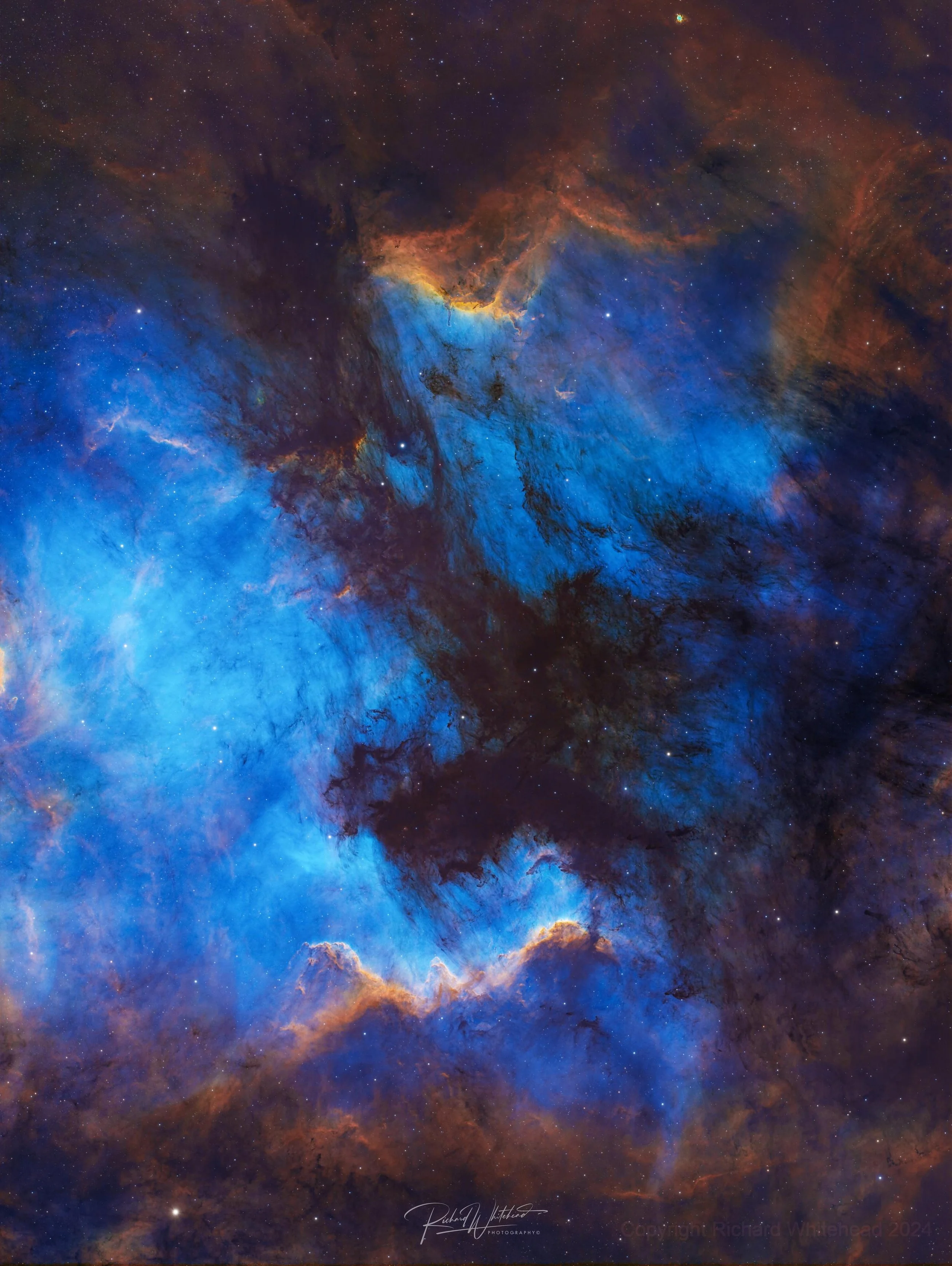
AAPOD2 Image Archives
The California Nebula
The California Nebula unfolds its vibrant hues in a stunning narrowband image. Captured through specialized filters, this rendition highlights the nebula's intricate details in sulfur, hydrogen, and oxygen wavelengths. Located in the constellation Perseus, approximately 1,000 light-years away, the California Nebula takes on a mesmerizing appearance, resembling the iconic U.S. state it is named after. This astrophotographic endeavor, utilizing the SHO (Sulfur, Hydrogen, Oxygen) narrowband technique, unveils the complex interplay of gases and dust, offering a glimpse into the dynamic processes shaping the nebula's cosmic landscape.
The Bear Claw Nebula
Image Description and Details :
The Bear Claw Nebula Sh2-200 is a very low brightness planetary Nebula discovered by Stuart Sharpless and incorporated into his catalog in 1959, although it wasn't until 2017 that it was spectroscopically confirmed as a planetary nebula!Planetary Nebulae are so called because to astronomers in years past, they looked disc-like, like a planet!.They are actually the remnants of a star reaching the end of its life and exploding into space, its outer layers, this will be the fate, one day of our sun.This is a very highly evolved and ancient planetary nebula.Someone has to call these objects, to me it looks more like a snow globe set adrift in a sea of glowing hydrogen ( that's the red background)Another fact that makes this image interesting is the halo of ionized Hydrogen gas that surrounds it. This is thought not to be linked to the planetary nebula, but the result of the extremely hot remnant star at its center ionizing the surrounding interstellar hydrogen.Tech stuffLocation: Animas, NMScope : Planewave CDK14Mount : Planewave L-350Camera : ZWO 6200 Mm Pro HOO ImageHa (Antlia 4.5nm) 25 x30 mins, OIII (Antlia 4.5nm) 25x30minsTotal Integration time 25 hoursProcessed in Pixinsight and PS
Copyright: Richard Whitehead 2022
M78
Squarespace <form-submission@squarespace.info>
Sun, Nov 21, 11:45 PM (9 hours ago)
to me
Sent via form submission from
Image Title: M78 -Stellar Birthplace
Upload your image file, please make your file name as unique as possible!: https://drive.google.com/open?id=1wfHP-6MgmX56a8kce4KuHX1mnfhO5BgR
Video Link?:
Date image was taken: 11/12/2021
Image Description and Details : Messier 78 is the other (IMHO) "great" nebula in Orion, sitting just above Orions' belt. M87 and its companion nebulae NGC2064, NGC2967, and NGC2071 are reflection nebulae in the Orion B molecular cloud. Reflection nebulae are where surrounding gas and dust is illuminated by stars.
They are usually blue in color, and for the same reasons our home world skies are blue.
The curvilinear shapes are carved out by the stellar wind of some very energetic stars.
M78 is the bright area in the center of the image, to the right of this there is a swirl of dust that looks just like the eye-wall of a hurricane, and the side lighting gives some 3-D information about the structure.
Lower to the left there is a dark nebula with tendrils and orange/red light peeping through, this is a stellar birthplace and home to 17 Herbig-Haro objects (energetic jets from new born stars)
I shot this image over 6 nights from the New Mexico desert, M78 still being a late riser so this image was shot at low elevation in the early hours of the morning. This is a full-frame image with minimal cropping at 2560mm focal length @ f7.
Tech stuff:
Scope : Planewave CDK14
Mount : Planewave L-350
Camera : ZWO ASI 6200 MM Pro ZWO filter wheel Astronomik filters
24 x 10 min Red
20 x10 min Green
18 x10 min Blue
All unguided. Darks no flats.
Shot as Bin 1 downsampled to Bin 2x2 in Pixinsight
Copyright: Richard Whitehead 2021
Tadpoles and Flaming Star Nebulae
Image Description and Details :
The Tadpoles Nebula (IC410) and Flaming Star Nebula in the Constellation of Auriga.I took this HaSHO image last week on a very rare almost clear night. In fact it was the clearest night in northern Vermont since last July!. Rather than completing some earlier projects I thought I’d shoot something entirely new, and go for these subjects as they (almost) fit on the same frame at 620mm focal length..The Tadpoles Nebula is so called due to the two light colored tadpole shaped dust and gas clouds that look like they are swimming upwards to the center of the nebula. These are star forming regions, similar to the famous “Pillars of creation” imaged by Hubble in the Eagle Nebula.To get an idea of scale each tadpole is 10 light years long!, more than twice the distance the earth is from its nearest stellar neighbor, Proxima Centauri.To the left is the Flaming Star nebula ( IC 405) which surrounds the variable star AE Aurigae. AE Aurigae is a “runaway” star ejected from gravitational perturbations in the Orion Nebula more than 2 million years ago.Its interesting to note that although these two nebulae appear close together the flaming star is 1500 Light years distant, whereas the Tadpoles Nebula is 12,000 lightyears away and over 100 light years across.This image is processed in the “Hubble Palette where red is aligned with Sulphur emissions, Green with Hydrogen , and Blue with Oxygen .Tech Data : Celestron RASA 11”, CGX Mount, ZWO ASI 6200MMPro cooled (Mono) camera.Ha 12 x 5min, OIII 18 x 5 mins, SII 9 x 5 mins, darks, flats, bias framesSoftware: Stacked in DSS, Processed in Pixinsight and PS 2021
Copyright: Richard Whitehead






